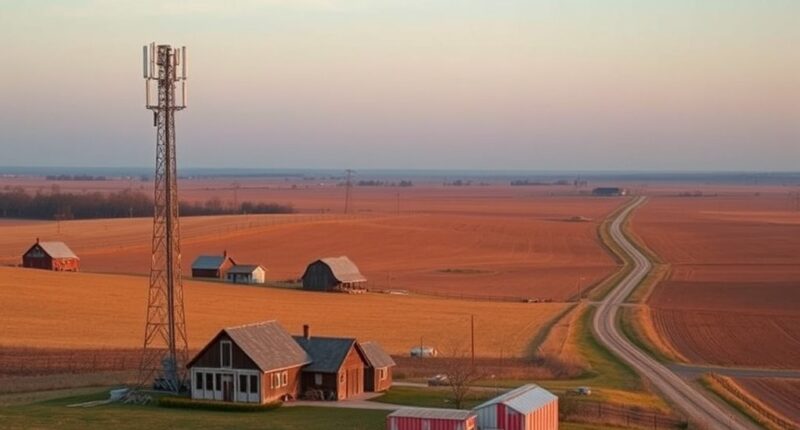Missouri is committed to bridging the digital divide by expanding rural broadband infrastructure. This effort guarantees residents and businesses get access to reliable, high-speed internet essential for work, education, healthcare, and everyday life. By forming public-private partnerships and focusing on fiber technology, Missouri aims to provide equitable connectivity across all communities. If you want to know how these initiatives can transform rural areas and improve digital inclusion, keep exploring the details.
Key Takeaways
- Missouri is expanding fiber infrastructure to improve high-speed internet access in rural communities.
- Public-private partnerships accelerate broadband deployment and overcome financial barriers.
- Enhanced broadband connectivity supports economic growth, healthcare, education, and remote work in rural areas.
- Fiber technology ensures reliable, scalable, and future-proof internet services for underserved regions.
- The initiative demonstrates Missouri’s commitment to digital equity and bridging the urban-rural digital divide.

Expanding broadband access in rural areas is essential for bridging the digital divide and opening new opportunities for residents and businesses alike. When you think about reliable internet, fiber infrastructure often comes to mind—it’s the backbone that provides high-speed, dependable connections. In Missouri’s rural communities, deploying fiber optic cables ensures that you can stream, work remotely, and access vital services without interruption. But building this infrastructure requires more than just laying cables; it demands strategic collaboration, often through public-private partnerships. These partnerships bring together government resources and private sector expertise, making it more feasible to extend fiber networks into hard-to-reach areas. You benefit from this collaboration because it accelerates project timelines, reduces costs, and leverages innovative solutions that might not emerge from public or private efforts alone. As a resident or business owner in a rural part of Missouri, you stand to gain considerably from these initiatives—faster internet speeds, improved reliability, and the ability to participate fully in the digital economy.
Public-private partnerships are essential because they help overcome financial and logistical barriers. The government can provide funding, grants, or incentives to encourage private companies to invest in fiber infrastructure that might otherwise be uneconomical. In turn, private firms bring technical expertise, advanced technology, and operational efficiency to the table. This synergy makes broadband expansion more sustainable and scalable, ensuring that you won’t just see short-term fixes but long-term solutions. These partnerships also often involve local communities in planning and decision-making, giving you a voice in how infrastructure is developed and tailored to your area’s specific needs. Additionally, the integration of innovative fiber optic technology enhances the quality and reach of the network, ensuring that rural areas receive the same level of service as urban centers.
Furthermore, these efforts don’t just benefit individual households—they boost local economies, attract new businesses, and improve access to healthcare, education, and government services. When you have access to high-speed internet, you can work remotely, access telehealth services, or participate in online education programs without the frustration of slow or unreliable connections. This connectivity becomes a critical lifeline, especially during emergencies or times of crisis. Missouri’s focus on expanding fiber infrastructure through public-private partnerships demonstrates a commitment to equitable growth, ensuring that rural communities aren’t left behind in the digital age. By supporting these initiatives, you help foster a more connected, resilient, and prosperous region where everyone has the opportunity to thrive in an increasingly digital world.
Frequently Asked Questions
How Does Broadband Expansion Impact Local Economies?
Broadband expansion boosts local economies by improving digital literacy, making residents more skilled and adaptable. It helps small businesses grow by providing faster, reliable internet for marketing, sales, and operations. With better connectivity, you can attract new customers, expand services, and innovate. This creates more job opportunities and encourages entrepreneurship, ultimately strengthening the community’s economic resilience. Enhanced broadband access is essential for fostering growth and competitiveness in your local area.
What Are the Main Challenges in Deploying Rural Broadband?
You face significant hurdles in deploying rural broadband, mainly due to infrastructure barriers that make installation complex and costly. Community engagement plays a vital role, as gaining local support can be challenging but is essential for success. Overcoming these obstacles requires collaborative efforts, innovative solutions, and patience—like planting seeds for future growth—so you can connect more homes and businesses, ultimately fostering stronger, more resilient communities.
Who Funds the Broadband Infrastructure Projects?
You can find funding for broadband infrastructure projects through federal grants and public-private partnerships. Federal grants provide essential financial support, especially for underserved rural areas, while public-private partnerships leverage collaboration between government agencies and private companies. These approaches help reduce costs, share risks, and ensure the expansion of reliable broadband. By combining these funding sources, you can effectively support the growth of rural broadband infrastructure.
How Will Broadband Access Be Maintained Long-Term?
You’ll see broadband access stay strong as ongoing investments focus on infrastructure resilience, ensuring systems withstand storms and wear. Digital literacy programs empower you to use the network effectively, reducing downtime and maintaining connections. Regular maintenance and upgrades, combined with community involvement, keep the infrastructure robust. By staying proactive, you’ll enjoy reliable internet now and in the future, making sure your digital access remains seamless and secure for years to come.
Are There Plans for Future Technology Upgrades in Rural Areas?
Yes, there are plans for future technology upgrades in rural areas. You’ll see continued improvements in wireless connectivity and tech innovation, ensuring your connection stays reliable and fast. As new advancements emerge, service providers are committed to upgrading infrastructure, so you can benefit from the latest technology. This ongoing effort aims to keep rural communities connected and competitive, adapting to changing digital needs and offering you better access now and in the future.
Conclusion
As you witness Missouri’s rural broadband expansion, remember it’s more than cables and signals—it’s a bridge over a chasm of isolation. This network becomes a essential thread, weaving communities closer and illuminating paths to opportunity. Just as a lighthouse guides ships through darkness, these digital links shine hope into every corner, symbolizing progress and unity. Together, you’re building a future where no one is left in the shadows, but embraced by the light of connection.









